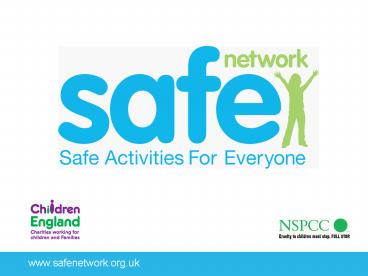NSPCC Generic PowerPoint Template
1 / 29
Title:
NSPCC Generic PowerPoint Template
Description:
ISA information provided is accurate at the time of presentation. NSPCC does not represent ... out opportunities to work their evil, no one can guarantee that they ... – PowerPoint PPT presentation
Number of Views:50
Avg rating:3.0/5.0
Title: NSPCC Generic PowerPoint Template
1
(No Transcript)
2
Safeguarding Children and young people
3
Facilitators
Facilitator
David Newton NSPCC, Training Associate
Fresh start
4
Aim
- To enable delegates to become familiar with
their role and responsibilities in the context of
safer recruitment and safeguarding children
within their organisation.
5
Workshop Assumptions
- Provide tips and signposts for more information,
but not produce experts - CRB is a tool but not the whole toolbox
- All cases are individual and require your
judgement - Every recruitment decision should be defensible
- Organisations should have clear guidelines for
inclusion of CRB checks in their recruitment
process - Recruitment will remain a risk, always, there is
no risk free checklist - Legal framework for the purposes of this training
covers only England and Wales - ISA information provided is accurate at the time
of presentation - NSPCC does not represent the ISA by providing
information on the Vetting and Barring Scheme
6
How we promote our work
- When you to join us in our work you will see
that the safety and welfare of our children, and
young people are at the very heart of everything
we do. We select carefully those who work closely
with all vulnerable groups. We are diligent in
ensuring we all behave in an appropriate way in
order to provide a safe and trust worthy service
to our community.
7
What is the problem
- For those agencies whose job it is to protect
children and vulnerable people, the harsh reality
is that if a sufficiently devious person is
determined to seek out opportunities to work
their evil, no one can guarantee that they will
be stopped. Our task is to make it as difficult
as possible for them to succeed - Bichard Inquiry Report, 2004 p12 para 79
8
Our Aim Our task is to make it as difficult
as possible for them to succeedBichard
Inquiry Report, 2004 p12 para 79
9
Beverley Allitt
10
Harold Shipman
11
Colin Norris
12
Eunice Spry
13
Daniel Gersh
14
RECRUITMENT
CRB
Qualifications
Interview
References
15
16
17
- SVG 2006
- Legislative framework for the new Vetting and
Barring scheme (VBS) run by the Independent
Safeguarding Authority (ISA) - Replaces multiple barring Lists in England
Wales and NI (List 99, PoCA, PoVA,
Disqualification Orders) - Continuous Monitoring
- Provides wide workforce coverage
- Pre-employment vetting
- Independent decision-making
- Wide range of information sources
- A reduction in bureaucracy
- Defines Controlled and Regulated activities
18
- ISA
- After 26 July 2010, it will be unlawful for
employers to engage anyone in regulated activity
without checking their registration status with
the ISA Scheme first. - ISA will take all discretionary barring decisions
ministers no longer involved - Employers will be notified if an individual is
de-registered from the scheme or if their status
changes (barring) - Does not replace CRB or Access NI checks
- CRB performs administrative role
- Some offences will lead to auto bar without
representation
19
- ISA
- Extends to paid workers, volunteers, current
workforce and overseas workers - Employers registered with CRB Access NI do not
have to register with the ISA - Will consider convictions and cautions,
inappropriate behaviour or behaviour likely to
cause harm to a child or a vulnerable adult - Will only inform if an individual is registered
and not barred - Certain organisations will be legally obliged to
refer relevant information to the ISA
20
Vetting and Barring
- ISA/ CRB
- To check or not to check?
- You decide.
21
Thank You
22
- The Legal Context
- Children Act 1989 paramountcy principle
- Rehabilitation of Offenders Act 1974
- Police Act 1997 (part v)
- Criminal Justice and Court Services Act 2000
- Safeguarding Vulnerable Groups Act 2006
23
- Policies
- Supporting policies
- Recruitment and Selection Policy (includes
Vetting) - Equal Opportunities Policy
- Directly relevant to CRB checking
- Recruitment of Ex-offenders policy
- Policy on obtaining, storage and destruction of
CRB checks
24
- Eligibility
- Who decides on eligibility?
- Roles listed in the Exceptions Order 1975 to the
ROA 1974 - Paid and unpaid workforce
- Overseas workers
- Change of role
- Retrospective checking
25
- Completing and Verifying Application Form
- Which Form?
- Originals only
- Role applied for - 'significant and relevant'
- Previous name and addresses
- Verification of ID documents (photo ID)
- Special cases the young / elderly /
impoverished communities / migrant labour /
transgender
26
- Understanding a Disclosure
- Police Records
- Cautions
- Information from section 142
- PoCA
- PoVA
- Other Relevant Information
27
- Some things to consider from the
- Disclosure
- Nature and seriousness of the offence
- Court disposal
- Relevance to the post
- Length of time since offence
- Single offence / history of offending
- Age at time of offence
- Pattern of offending
28
- Some things you can only get from the
- applicant
- The circumstances of the offence
- Change in individual circumstance
- Attitude to the offence (s)
- Efforts made not to re-offend
- Aggravating and mitigating circumstances
29
Summary
- Use disclosure information sensitively
- Follow the CRB Code of Practice
- Ensure all other vetting checks are completed
- Gather as much relevant information as possible
- Do not over rely on CRB checks
- Discuss disclosures with content with applicants
and carry out risk assessments - Your decisions must stand up to scrutiny
- Be consistent
- Record process, rational and outcome
- Use your informed judgement































